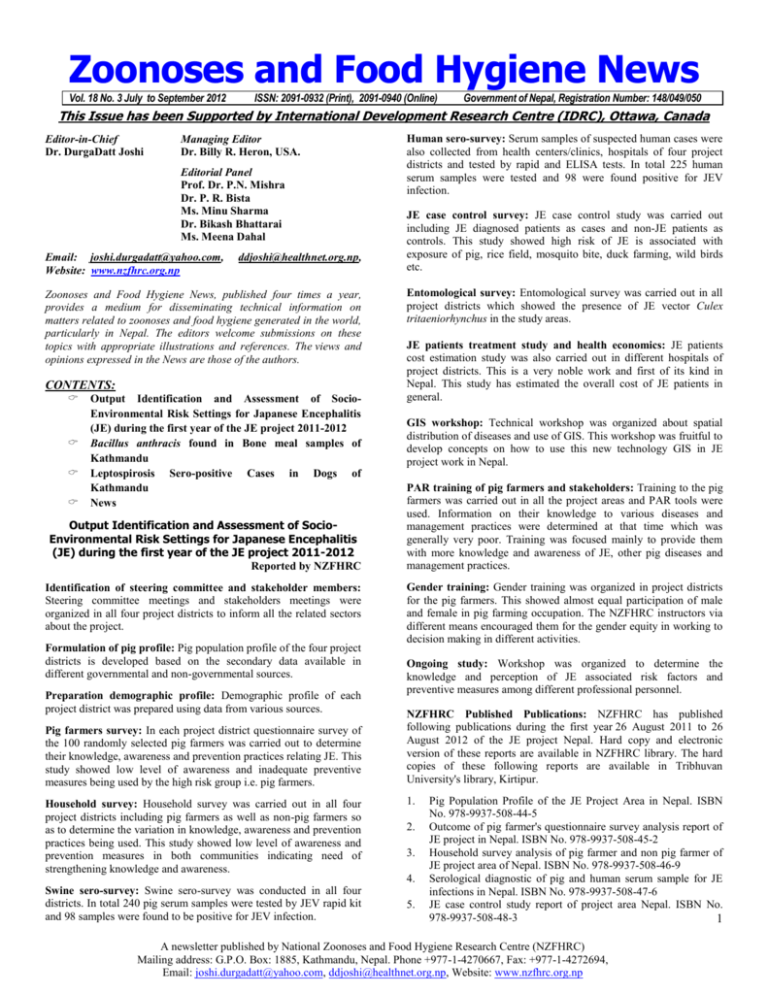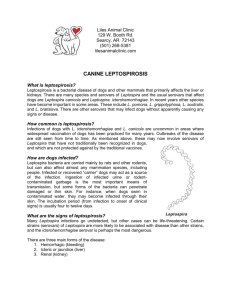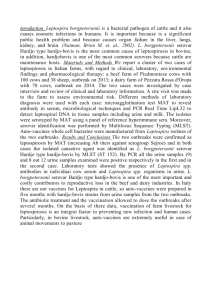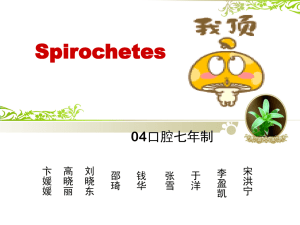Zoonoses and Food Hygiene News
advertisement

Zoonoses and Food Hygiene News Vol. 18 No. 3 July to September 2012 ISSN: 2091-0932 (Print), 2091-0940 (Online) Government of Nepal, Registration Number: 148/049/050 This Issue has been Supported by International Development Research Centre (IDRC), Ottawa, Canada Editor-in-Chief Dr. DurgaDatt Joshi Managing Editor Dr. Billy R. Heron, USA. Editorial Panel Prof. Dr. P.N. Mishra Dr. P. R. Bista Ms. Minu Sharma Dr. Bikash Bhattarai Ms. Meena Dahal Email: joshi.durgadatt@yahoo.com, Website: www.nzfhrc.org.np ddjoshi@healthnet.org.np, Zoonoses and Food Hygiene News, published four times a year, provides a medium for disseminating technical information on matters related to zoonoses and food hygiene generated in the world, particularly in Nepal. The editors welcome submissions on these topics with appropriate illustrations and references. The views and opinions expressed in the News are those of the authors. CONTENTS: Output Identification and Assessment of SocioEnvironmental Risk Settings for Japanese Encephalitis (JE) during the first year of the JE project 2011-2012 Bacillus anthracis found in Bone meal samples of Kathmandu Leptospirosis Sero-positive Cases in Dogs of Kathmandu News Output Identification and Assessment of SocioEnvironmental Risk Settings for Japanese Encephalitis (JE) during the first year of the JE project 2011-2012 Reported by NZFHRC Identification of steering committee and stakeholder members: Steering committee meetings and stakeholders meetings were organized in all four project districts to inform all the related sectors about the project. Formulation of pig profile: Pig population profile of the four project districts is developed based on the secondary data available in different governmental and non-governmental sources. Preparation demographic profile: Demographic profile of each project district was prepared using data from various sources. Pig farmers survey: In each project district questionnaire survey of the 100 randomly selected pig farmers was carried out to determine their knowledge, awareness and prevention practices relating JE. This study showed low level of awareness and inadequate preventive measures being used by the high risk group i.e. pig farmers. Household survey: Household survey was carried out in all four project districts including pig farmers as well as non-pig farmers so as to determine the variation in knowledge, awareness and prevention practices being used. This study showed low level of awareness and prevention measures in both communities indicating need of strengthening knowledge and awareness. Swine sero-survey: Swine sero-survey was conducted in all four districts. In total 240 pig serum samples were tested by JEV rapid kit and 98 samples were found to be positive for JEV infection. Human sero-survey: Serum samples of suspected human cases were also collected from health centers/clinics, hospitals of four project districts and tested by rapid and ELISA tests. In total 225 human serum samples were tested and 98 were found positive for JEV infection. JE case control survey: JE case control study was carried out including JE diagnosed patients as cases and non-JE patients as controls. This study showed high risk of JE is associated with exposure of pig, rice field, mosquito bite, duck farming, wild birds etc. Entomological survey: Entomological survey was carried out in all project districts which showed the presence of JE vector Culex tritaeniorhynchus in the study areas. JE patients treatment study and health economics: JE patients cost estimation study was also carried out in different hospitals of project districts. This is a very noble work and first of its kind in Nepal. This study has estimated the overall cost of JE patients in general. GIS workshop: Technical workshop was organized about spatial distribution of diseases and use of GIS. This workshop was fruitful to develop concepts on how to use this new technology GIS in JE project work in Nepal. PAR training of pig farmers and stakeholders: Training to the pig farmers was carried out in all the project areas and PAR tools were used. Information on their knowledge to various diseases and management practices were determined at that time which was generally very poor. Training was focused mainly to provide them with more knowledge and awareness of JE, other pig diseases and management practices. Gender training: Gender training was organized in project districts for the pig farmers. This showed almost equal participation of male and female in pig farming occupation. The NZFHRC instructors via different means encouraged them for the gender equity in working to decision making in different activities. Ongoing study: Workshop was organized to determine the knowledge and perception of JE associated risk factors and preventive measures among different professional personnel. NZFHRC Published Publications: NZFHRC has published following publications during the first year 26 August 2011 to 26 August 2012 of the JE project Nepal. Hard copy and electronic version of these reports are available in NZFHRC library. The hard copies of these following reports are available in Tribhuvan University's library, Kirtipur. 1. 2. 3. 4. 5. Pig Population Profile of the JE Project Area in Nepal. ISBN No. 978-9937-508-44-5 Outcome of pig farmer's questionnaire survey analysis report of JE project in Nepal. ISBN No. 978-9937-508-45-2 Household survey analysis of pig farmer and non pig farmer of JE project area of Nepal. ISBN No. 978-9937-508-46-9 Serological diagnostic of pig and human serum sample for JE infections in Nepal. ISBN No. 978-9937-508-47-6 JE case control study report of project area Nepal. ISBN No. 978-9937-508-48-3 1 A newsletter published by National Zoonoses and Food Hygiene Research Centre (NZFHRC) Mailing address: G.P.O. Box: 1885, Kathmandu, Nepal. Phone +977-1-4270667, Fax: +977-1-4272694, Email: joshi.durgadatt@yahoo.com, ddjoshi@healthnet.org.np, Website: www.nzfhrc.org.np 6. 7. 8. 9. 10. 11. 12. 13. 14. 15. 16. 17. 18. 19. Entomological profile of the JE project area in Nepal. ISBN No. 978-9937-508-49-0 Health economics JE patient cost analysis report. ISBN No. 9789937-508-50-6 Epidemiological surveillance status of JE outbreak in project area of Nepal. ISBN No. 978-9937-508-43-8 Technical workshop proceedings and spatial analysis of GIS. ISBN No. 978-9937-508-41-4 Demographic profile of the project area. Kathmandu, Morang, Rupandehi and Kapilvastu districts. ISBN No. 978-9937-50839-1 Reports on steering committee and stakeholder of JE control project of Nepal. ISBN No. 978-9937-508-40-7 Application of PAR tools awareness about JE and knowledge dissemination among pig farmers. ISBN No. 978-9937-508-38-4 Young and mid research career students reports. ISBN No. 9789937-508-42-1 Year 1 Interim Technical Report Reducing Vulnerability to the Threats of JE Transmission in High Risk Districts in Nepal, August 2011-August 2012. ISBN No. 978-9937-508-52-0 Gender Training among Pig Farmer of JE Project. ISBN No. 978-9937-508-54-4 Inception Workshop Report of JE Project in Nepal. ISBN No. 978-9937-508-53-7 Biostatistic Methods Used for Controlling Infectious Diseases. ISBN No. 978-9937-508-55-1 Knowledge and Perception of Japanese Encephalitis Associated with Risk Factors and Preventive Measures Among Different Professional Personnel. ISBN No. 978-9937-508-56-8 Proceeding report on first annual progress review workshop on "Japanese encephalitis project in Nepal". ISBN No. 978-9937-508-68-1 Bacillus anthracis found in bone meal samples of Kathmandu D. D. Joshi and Anita Ale INTRODUCTION Anthrax is an infectious disease due to a type of bacteria called Bacillus antracis. Infection in humans most often involves the skin, gastrointestinal tract, or lungs. Anthrax commonly affects hoofed animals such as sheep, cattle, and goats, but humans who come into contact with infected animals can get sick from anthrax, too. In the past, the people who were most at risk for anthrax included farm workers, veterinarians, and tannery and wool workers. (ADAM Encyclopedia, 2011). There are three main routes of anthrax infection. The cutaneous anthrax occurs when anthrax spores touch a cut or scrape on the skin and it is the most common type of anthrax infection. The main risk factor is contact with animal hides or hair, bone products, and wool, or with infected animals. People most at risk for cutaneous anthrax include farm workers, veterinarians, and tannery and wool workers. Inhalation anthrax develops when anthrax spores enter the lungs through the respiratory tract. It is most commonly contracted when workers breathe in airborne anthrax spores during processes such as tanning hides and processing wool. The third type gastrointestinal anthrax occurs when someone eats anthrax-tainted meat (ADAM Medical Encyclopedia, 2011). Due to the long persistence of anthrax spores in soil, no country can claimed absolute freedom from the agent, but regular outbreaks usually occur in limited geographic regions. Endemic foci exist in most parts of the world, including Africa, Asia, United States and Australia (Lewerin et.al., 2010). Bone meal can also form a potential risk factor for anthrax transmission. That’s why this study was conducted whereby bone samples from different feed industries of Nepal were tested for anthrax. METHODOLOGY Bone meals were collected from different feed industries of Nepal namely Quality Fed and Cold Storage – Kathmandu, Valley Feed Industries – Kathmandu and Aadhunik Poultry Feed Products Pvt. Ltd. – Kathmandu. A total of 15 samples were collected during the month of March, 2012. The bone meal samples were collected and sealed in the plastic packet. Those samples were dispatched to Dr. Antonio Fasanella, Head, Responsible of Anthrax Reference Center of Italy and Department of Biotechnology and Vaccines, for the test of Anthrax by G.A.B.R.I. method procedures, which permits the isolation of anthrax from soil characterized by low level on contamination. RESULTS AND DISCUSSION Out of the 15 pooled bone samples tested by G.A.B.R.I. procedure, 3 samples were found to be infected with Bacillus anthracis. Meat and bone meal can form a potential source for large scale anthrax outbreak. A large outbreak, associate with imported meat and bone meal, occurred in the country of Holland in the 1950s (Sterne, 1966). Anthrax infection in bone meal from various countries including Pakistan and India were also reported by Davies and Harvey (1972). Anthrax cases had been reported from different species of animals in Nepal in different years. According to the veterinary epidemiological center bulletin (July-Dec., 2009) there were 7 cases from July to Dec., 2009 with fatality 86% (6 of 7 dead). However, there is little published information available in Nepal regarding anthrax infection in meat and bone meals. This finding suggests for a possible health hazard existing with Bacillus anthracis infection to factory workers, bone meal handlers and whoever gets exposed to the contaminated bone meals. CONCLUSION The finding of this study indicates the presence of anthrax bacilli in bone meals in Nepal. Detailed study needs to be carried out to find the existing anthrax threat in the country. Proper preventive measures should be taken by the workers and bone meal handlers to prevent the possible threat of anthrax transmission. REFERENCES A.D.A.M. Medical Encyclopedia, 2011. Anthrax. Retrieved from http://www.ncbi.nlm.nih.gov/pubmedhealth/PMH0002301/ Lewerin SS, Elvander M, Westermark T, Hartzell LN et. al. 2010. Anthrax outbreak in a Swedish beef cattle herd-1st case in 27 years: Case report. Acta. Vet Scand, 1;52:7. Sterne, M. 1966. Anthrax. In: International encyclopedia of veterinary medicine. Dalling T., Robertson A, Boddie GF, Spruell JA (edit.). W Green &Son Ltd., Edinburgh. Pp: 221-230. Davies DG and Harvey RWS. 1972. Anthrax infection in bone meal from various countries of origin. J Hyg (Lond), 70 (3): 455-457. Veterinary Epidemiology Center bulletin. 2009. Six-monthly epidemiological bulletin July-Dec 2009. Veterinary Epidemiology Center, Directorate of Animal Health, Tripureshwor, Kathmandu. Leptospirosis Seropositive Cases in Dogs of Kathmandu Sulekha Sharma, D. D. Joshi, Mukti Shrestha and K. B. Shrestha ABSTRACT This study was done to determine the seroprevalence of leptospirosis in dogs. From February to June 2012, a total of 60 dogs were selected from the Central Veterinary Hospital, Tripureshwor and dog sanctuary of Animal Nepal, Chobar. Forty dogs were female and 20 were male. Only 30 were vaccinated against leptospira. The collected samples were of 2 months to 12 years age group. Dog sera were collected from radial vein and kept refrigerated until rapid diagnostic test for anti-leptospira IgM and IgG (SD Bioline) at the NZFHRC, Chagal. The prevalence of Leptospira IgG antibodies was 6.67 % (4/60). None of the samples tested were positive for IgM. Out of the 4 IgG positive tests, 2 were from males and 2 were from vaccinated2 A newsletter published by National Zoonoses and Food Hygiene Research Centre (NZFHRC) Mailing address: G.P.O. Box: 1885, Kathmandu, Nepal. Phone +977-1-4270667, Fax: +977-1-4272694, Email: joshi.durgadatt@yahoo.com, ddjoshi@healthnet.org.np, Website: www.nzfhrc.org.np Keywords: Leptospirosis, Leptospira, Rapid diagnostic test INTRODUCTION Leptospirosis, caused by spirochetes of the genus Leptospira, is considered the most wide-spread zoonosis in the world (WHO, 1999). The infection is however more common in the tropical and sub-tropical countries, since favorable conditions for its transmission exists there and most of the countries in this region are developing ones (Bharti et al., 2003; WHO, 2003). Canine leptospirosis, first described in 1899, has received increased attention as a cause of febrile illness and hepatic renal disease (Bolin CA, 1996). The canine disease presents as an acute infection of the kidney and liver and sometimes as a septicemia. Chronic kidney disease is a common sequel of infection and abortions may occur in pregnant dams (McDonough P. L., 2001). Leptospirosis is believed to be endemic as ideal conditions exist for transmission of this infection in Nepal (Brown et al., 1981), however, as with other developing countries, infection is largely underreported. Though Leptospira in dogs has been reported in Southeast Asia including India, Bangladesh and Pakistan, there is lack of baseline information about its prevalence in Nepal. Therefore, this study aims to detect the seroprevalence of Leptospira in dogs of Kathmandu. METHODOLOGY This hospital and dog sanctuary based prospective cross-sectional study was conducted from Feb. to June, 2012 at NZFHRC. Altogether 60 blood samples were collected from Central Veterinary Hospital, Tripureshwor from the dogs presented for the treatment of ill health with the oral consent from the owners and dog sanctuary of Animal Nepal, Chobhar from the stray dogs brought for the treatment of ill health and spaying (in case of females). Blood sample was collected from the radial vein with a 21 G needle and a 3 ml syringe. The blood samples were allowed to clot and then centrifuged at 2000 rpm for 15 minutes. The serum sample was then kept separated and stored in a cryovial at 2-8°C until tested. Each serum sample was tested for Leptospira IgG/IgM by rapid test kit method (SD Bioline). RESULT A total of 60 blood samples were collected from Central Veterinary Hospital (CVH), Tripureshwor and dog sanctuary of Animal Nepal, Chobhar. Of the total samples, 20 were of male, 40 were of female and 30 were of vaccinated dogs. Table 1: Demographic status of dog cases tested for Leptospira Site of sample collection No. of male No. of female Total CVH 7 2 9 Dog Sanctuary 13 38 51 Total 20 40 60 Pattern of RDT results: Seroprevalence of Leptospira IgG was 6.67% (4/60). Leptospira IgM was detected in none of the collected samples (Figure 1). Seroprevalence of Leptospira IgG 6.67 Positive (%) Negative (%) 93.33 Figure 1: Seroprevalence of Leptospira IgG among dogs by rapid diagnostic test kit. Age wise distribution of Leptospira cases among dogs Among the Leptospira positive cases, the highest number of cases belonged to the age group 12-24 months (Figure 2). Age wise prevalence of Leptospira among dogs 30 No. of samples dogs. The presence of Leptospira IgG antibodies showed that the dogs were having chronic infection with Leptospira spp. 25 20 Tested No. 15 Positive No. 10 5 0 1 to 12 12 to 24 24 to 36 36 to 48 48 to 60 60 to 72 Age group (months) Figure 2: Age wise prevalence of Leptospira among dogs. Gender wise distribution of Leptospira cases among dogs: Leptospira positivity was found to be more in males (Table 2). Table 2: Gender wise prevalence of Leptospira among dogs Sex Tested No. Positive No. Male 20 2 Female 40 2 Vaccination status with Leptospira IgG positivity in dogs: The Leptospira IgG was found in vaccinated as well as unvaccinated dogs (Table 3). Table 3: Vaccination status with Leptospira IgG positivity in dogs Sex Tested No. Positive No. Vaccinated 30 2 Unvaccinated 30 2 DISCUSSION Seroprevalence of the study was 6.67% (4/60). Chuan-Jiang Lai et al (2005) found 45.6% seropositivity of Leptospira in dogs in Northern Taiwan. However Tongkorn Meeyam et al, (2004) found 11% in Thailand and Raju Gautam et al (2010) found 8.1% in USA seropositivity of Leptospira antibodies in dogs. The prevalence of Leptospira antibodies in dogs has varied among different countries: 21.3% in India and 6.36% in Italy (Cerri et al, 2003). Climate may be an important factor affecting the prevalence of Leptospira in each area. The suitable climate for Leptospira is the tropical climate, and the prevalence of Leptospira has been found to be the highest in the rainy season (Ward et al, 2002). Prescott et al (1991) found 8.2% seropositivity in dogs in Southern Ontario. In a retrospective study conducted by Kikuti M, et al from 2003 to 2010 at the Laboratory of Zoonosis Diagnosis at the Veterinary Hospital of São Paulo State University (UNESP) in Botucatu, São Paulo state, Brazil, the seroprevalence was 20.08%. Seroprevalence of Leptospira among cattle and buffaloes was found to be 5.5% and 11% respectively in Nepal (Joshi and Joshi, 2000, 2001). Similar serological survey was done throughout Nepal by Dyson et al., (2000). They found the prevalence rate of 17% in different species of livestock, and suggested that chronic infection is very common. Leptospira positivity was more in males in this study. However, Harkin and Gartrell in 2002 and Miller et al (2007) identified more infected females than males while in 1992 Rentko et al and Zwijnenberg et al (2008) found more infected males than females. In a study conducted by Dayou Shi et al (2012), no significant difference was observed. In a retrospective study conducted by Kikuti M et al from 2003 to 2010 at the Laboratory of Zoonosis Diagnosis at the Veterinary Hospital of São Paulo State University (UNESP) in Botucatu, São Paulo state, Brazil male dogs were connected with higher rates of leptospirosis antibodies. 3 A newsletter published by National Zoonoses and Food Hygiene Research Centre (NZFHRC) Mailing address: G.P.O. Box: 1885, Kathmandu, Nepal. Phone +977-1-4270667, Fax: +977-1-4272694, Email: joshi.durgadatt@yahoo.com, ddjoshi@healthnet.org.np, Website: www.nzfhrc.org.np There is no significant difference of Leptospira positivity among vaccinated and unvaccinated dogs. The unvaccinated dogs were positive to Leptospira IgG which showed that they were chronically infected. The vaccinated dogs might have shown positivity due to recent vaccination. IgM class antibodies usually appear somewhat earlier than IgG class antibodies, and generally remain detectable for months or even years but at low titre. Detection of IgG antibodies is more variable. They may sometimes not be detected at all, or be detectable for only relatively short periods of time, but may sometimes persist for several years. Immunity to leptospirosis is primarily humoral, (i.e. mediated by antibody-producing branch of the immune system), the result of B-cell and Th-2 T-helper (CD4) cell stimulation. Cell-mediated immunity does not appear to be important, but may be responsible for some of the late manifestation of the disease (http://www.searo.who.int/LinkFiles/CDS_leptospirosisFact_Sheet.pdf). Leptospira vaccination (combined) is given at 6-8 weeks (1st prick) and at 12-16weeks of age (2 nd prick) followed by booster dose annually in Nepal. In India, Leptospira vaccination (combined) is done at 6 weeks of age (1st prick) and at 2-3 weeks later upto 16 weeks (2nd prick) followed by booster dose annually (http://dogsindia.com/vaccination_schedule.htm). REFERENCES Bolin, C. A. 1996. Diagnosis of leptospirosis: a reemerging disease of companion animals. Semin Vet Med Surg (Small Animal), 11, pp. 166-71. Brown, C. A., Roberts, A. W., Miller, M. A., David, D. A., Brown, S. A., Bolin, C. A., Jarecki-Black, J., Greene, C. E., Miller-Liebl, D. 1996. Leptospira interrogans serovars grippotyphosa infection in dogs. J Am Vet Med Assoc, 209, pp. 1265-1267. Brown, G. W., Madasamy, M., Bernthal, P., Groves, M. G. 1981. Leptospirosis in Nepal. Transactions of the Royal Society of Tropical Medicine and Hygiene, 75, pp. 572-573. Cerri, D., Ebani, V., Fratini, F., Pinzauti, P., Andreani, E. 2003. Epidemiology of leptospirosis: observations on serological data obtained by a “diagnostic laboratory for leptospirosis” from 1995 to 2001. New Microbiol, 26, pp. 383-9. Dyson D, Sharma B, and Pant G R. 2000. Investigation on infertility in cattle and buffaloes in Nepal. Veterinary Review (Kathmandu), pp. 15. Harkin, K. R, Roshto, Y. M., Sullivan, J. T., Purvis, T. J., Chengappa, M. M. 2003. Comparison of polymerase chain reaction assay, bacteriologic culture and serologic testing in assessment of prevalence of urinary shedding of Leptospires in dogs. J Am Vet Med Assoc, 222, pp. 1230-1233. Joshi, H. D., Joshi, B. R. 2000. Detection of Leptospira hardjo antibodies in infertile cattle and buffaloes in the western hills of Nepal. Veterinary Review (Kathmandu), pp. 15. Joshi, H. D., Joshi, B. R. 2001. Detection of Leptospira hardjo antibodies in cattle and buffaloes with infertility problems in the western hills of Nepal. In: Working Paper - Lumle AgriculturalResearch Centre. Agricultural Research Station Lumle, Pokhara Nepal. Kikuti, M., Langoni, H., Nobrega, D. N., Corrêa, A. P. F. L. and Ullmann, L. S. 2012. Occurrence and risk factors associated with canine leptospirosis. J. Venom. Anim. Toxins incl. Trop. Dis, 18, pp. 1 McDonough, P. L. 2001. Leptospirosis in Dogs - Current Status. In: Recent Advances in Canine Infectious Diseases, L. Carmichael (Ed.). Prescott, J. F., Ferrier, R. L., Nicholson, V. M., Johnston, K. M., Hoff, B. 1991. Is canine leptospirosis underdiagnosed in southern Ontario? A case report and serological survey. Can J Vet Res., 32, pp. 481–486. Raju Gautam, Ching-Ching Wu, Lynn F. Guptill, Adam Potter; George E. Moore. 2010. Detection of antibodies against Leptospira serovars via microscopic agglutination tests in dogs in the United States, 2000–2007, JAVMA, 3, pp. 237. Ward, M. P., Guptill, L. F., Prahi, A., WuCC. 2004. Serovar-specific prevalence and risk factors for leptospirosis among dogs: 90 cases (1997-2002). Journal of Animal Veterinary Medicine Association, 224, pp. 1958-1963. Ward, M. P., Glickmann, L. T. and Guptill, L. E. 2002. Prevalence of and risk factors for leptospirosis among dogs in the United States and Canada: 677 cases (1970-1998). Journal of the American Veterinary Medical Association, 220, pp. 53-58. NEWS Establishment of One Health Alliance South Asia (OHASA) – NEPAL: One Health Alliance South Asia (OHASA) Nepal chapter has been established in Nepal. The first meeting of OHASA, Nepal was held on August 26, 2012 under the Chairmanship of Dr. D D Joshi with the presence of following members from different organizations at NZFHRC meeting hall. Dr. Durga Datt Joshi Executive Chairman of National Zoonoses and Food Hygiene Research Center was coordinator of OHASA-N and NZFHRC will be the secretariat of OHASA-N. During the meeting, OHASA-N member highlighted the importance of one health approach to address the emerging and reemerging issues of zoonoses, food safety and other issues of animal, human and environmental health in the changing context of globalization. Second meeting of OHASA-N was held under the Chairmanship of Dr. Garib Das Thakur, Director, Epidemiology and Disease Control Division at the meeting hall of EDCD on 23rd September 2012. K.D.M.A. Research Award: Please kindly submit your research work paper on allergy award for the year 2011 for the consideration by the end of December 2012 to KDMART office Chagal, G.P.O. Box 1885, Kathmandu, Nepal, Phone: 4270667, 4274928 and Fax 4272694. This award was established by Dr. D.D. Joshi in 2049 B.S. (1992) on the memory of his wife, the late Mrs. Kaushilya Devi Joshi. The award includes a grant of NCRs. 10,001 with certificate. From: Zoonoses& Food Hygiene News, NZFHRC P.O. Box 1885, Chagal, Kathmandu, Nepal. TO: Dr/Mr/Ms ........................................ ............................................................ 4 A newsletter published by National Zoonoses and Food Hygiene Research Centre (NZFHRC) Mailing address: G.P.O. Box: 1885, Kathmandu, Nepal. Phone +977-1-4270667, Fax: +977-1-4272694, Email: joshi.durgadatt@yahoo.com, ddjoshi@healthnet.org.np, Website: www.nzfhrc.org.np ............................................................. 5 A newsletter published by National Zoonoses and Food Hygiene Research Centre (NZFHRC) Mailing address: G.P.O. Box: 1885, Kathmandu, Nepal. Phone +977-1-4270667, Fax: +977-1-4272694, Email: joshi.durgadatt@yahoo.com, ddjoshi@healthnet.org.np, Website: www.nzfhrc.org.np







